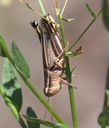Two-striped Grasshopper
Melanoplus bivittatus
Classification
- Phylum: Arthropoda
- Subphylum: Hexapoda
- Class: Insecta
- Order: Orthoptera
- Suborder: Caelifera
- Family: Acrididae
- Subfamily: Melanoplinae
- Tribe: Melanoplini
- Genus: Melanoplus
- Species: bivittatus
Pronunciation
How to pronounce Melanoplus bivittatus: //mɛˈlænoʊpləs baɪˈvɪtətəs//
These audio files are automatically generated. While they are not always 100% accurate, they are a good starting point.
Images






Summary
Melanoplus bivittatus, commonly known as the Two-striped Grasshopper or Yellow-striped Grasshopper, is prevalent in North America, known for its distinctive stripes and agricultural pest status.
Physical Characteristics
30-55 mm in size; yellowish to brown coloration with two distinct pale yellowish stripes along sides. Male with boot-shaped cerci. Coloration can vary with region.
Identification Tips
Look for the two pale yellow stripes running from above the eyes to the hind tip of the wings; males have boot-shaped cerci.
Habitat
Found in sunny, moist, lush, weedy or meadowy areas; meadows, prairies, crop fields, road sides, vacant lots, ditch and stream sides, and vegetable gardens.
Distribution
Coast to coast across southern Canada and most of the US except Florida and southwestern arid regions. May extend into northernmost Sonora and Chihuahua, Mexico.
Diet
Polyphagous; primarily herbaceous Dicots, may also consume herbaceous Monots, leaves of woody plants, and even dead animal matter when food is scarce.
Life Cycle
Overwinters as eggs in the ground or organic material; eggs hatch in late April to early May, going through five instars during development.
Reproduction
Mating can last up to 10 hours, involving nuptial gifts (spermatophores) provided by males. Females can delay fertilization after mating for up to 21 days.
Ecosystem Role
Can be a pest in agricultural environments due to crop damage; may impact plant reproduction.
Economic Impact
Can cause significant crop damage, impacting farmers economically through loss of yield.
Collecting Methods
- Sweep netting
- Hand collecting
Preservation Methods
- Ethanol
- Freezing
- Pinning
Evolution
Related to Melanoplus thomasi, which is distinguished by its coloration and habitat preferences. Some authors have debated the classification of subspecies based on physical differences.
Similar Taxa
Misconceptions
Some confusion arises from regional variations and the differentiation between subspecies, particularly concerning hind tibiae coloration.
Tags
- grasshopper
- Melanoplus bivittatus
- agricultural pest
- North America
- Orthoptera